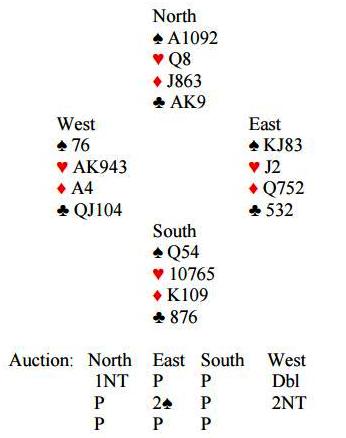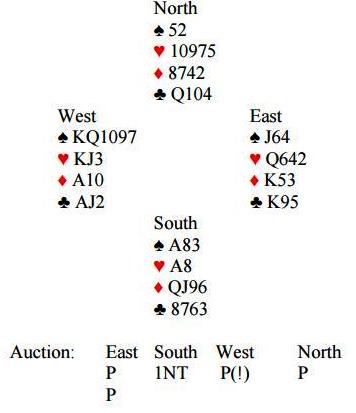Source: www.omahabridge.org
An opening bid of 1NT that shows a balanced hand in the range of 10-12, 11-14, 12-14, or 13-15 HCP’s (or thereabouts) is considered a Weak Notrump. Generally in the United States and Canada a standard 1NT opening bid shows a balanced hand with a point range of 15 to 17 or 16 to 18 HCP’s; thus the term Weak Notrump for a similar hand with fewer values.
I am convinced that one of the best ways to learn how to play against weak notrumps is to play them for awhile. Once you get used to them, they aren’t so very difficult to defend or to bid against. Besides playing them is FUN!
Jeremy Flint, the late great British bridge player and writer stated, in defense of weak notrumps (they are considered standard in Great Britain): «American writers, nurtured on their standard strong notrumps tend to inform their readers that the weak notrump creates many problems. So it does–for the opposition!» Having played weak notrumps for years I wholeheartedly agree with that assessment.
Weak notrumps seem to have several advantages over the strong notrumps:
(1) With one bid (the opening bid), the opener gets to show a minimum balanced hand. There is no problem with which «right» suit to open and there is no rebid problem.
(2) Because hands that would normally be opened with a 15-17 NT are now opened with one of a minor suit, there is the advantage of permitting the responding hand to bid on poor hands thus enabling the partnership to find a good suit fit that would otherwise have been missed.
(3) Since all balanced minimum hands are opened with 1NT, constructive bidding with unbalanced hands is enhanced when the opening bid is one of a suit.
(4) There is a preemptive value in the 1NT opening bid. Opponents must either start their own communication process at the two-level or stay out of the auction because they lack the values to overcall at the two-level.
(5) Weak notrumps seem to invite ill-advised competition and the partner of the 1NT opener is in an excellent position to judge the best position for their side.
The following two hands occurred back-to-back in a recent pairs game (read matchpoints). They are presented, not to belittle the opponents, but to illustrate the problems weak notrump present for inexperienced players.
Hand 1: East-West vulnerable; Dealer North
East-West were playing Cappelletti versus both weak and strong notrumps but seemed to have the understanding (or perhaps misunderstanding), that in the passout position, double was for takeout, not penalty; hence the unfortunate ugly auction. This contract had almost no chance to make and when the smoke had cleared they were down two (-200) which was very good for North-South! Notice that if East-West had passed through out and defended well, they at least had a chance for a plus score. There are several things to consider on this hand: (1) if you double 1NT and partner doesn’t sit for the double, to now bid 2NT must show a huge hand because you’re going to be playing opposite a bad hand, (2) if partner is likely to remove your double to some suit higher than one you want to play in, it’s probably better just to bid your suit in the first place, and (3) if your declarer play is only average or below, be more conservative in the bidding! 
I’m convinced that this hand happened as a result of the previous hand. The West person was now afraid to bid….so what happened? This time they got no matchpoints as they have a vulnerable game available to them but instead defended 1NT undoubled and beat it only one trick.Now I realize that the East-West pair were somewhat shaken after the first board, but we all know that Rule Almost # 1 at duplicate bridge is to let go of a hand after it’s played.
If the East-West pair were even somewhat consistent on these two boards and had doubled both for penalties (and defended decently) they would have at least been average for the round.
